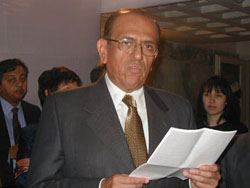| When Mr. Victor Muñoz, Deputy Chief of Mission of the Embassy of Peru in Delhi talked to me at a wine club dinner about wines from Peru, I was slightly nonplussed. I had frankly not heard of Peru making wines though I was vaguely familiar with Tacama as a wine brand. At his request, we had a few of our members taste a bottle each of Tacama red and white wine and found it quite palatable. We agreed to have a tasting session of these wines for our members and a few other guests, namely importers and restaurateurs. To this tasting they would also add Pisco, their favourite national drink, made by double distillation of wine. His Excellency, Mr. Benjamin Ruiz graciously offered to host the wine and Pisco Tasting at his residence on Monday the 15th December.
Peru is a natural wine producer as it borders Chile to its South. Its coastline touches Pacific  Ocean just like in Chile and the Central coast in California. It is the 5th largest wine producer in Latin America, though only one tenth the size of Chile in wine growing area (27.2k acres compared to 282k in Chile and a whopping 512k acres in Argentina.) Ocean just like in Chile and the Central coast in California. It is the 5th largest wine producer in Latin America, though only one tenth the size of Chile in wine growing area (27.2k acres compared to 282k in Chile and a whopping 512k acres in Argentina.)
Historically, Peru has been known to grow grapes at least since Chile started growing them. In 1563, when Spain conquered Chile and brought shiploads of vines from Spain and France, a sizeable amount was also shipped from Valparaiso,
Chile to Lima. Of course, unlike Chile but like India, Peru has had the problem of Phylloxera. Also detrimental has been a decree by the military government in the 1960s taking land from the feudal landowners and distributing it to small farmers, which ruined the wine industry.
Most vineyards are located in the Ica province, located in the south of Lima, in a fertile oasis surrounded by the desert where it is hot and semi arid, necessitating irrigation. Tacama is the major international brand though brands like Tabernero, Ocucaje and Vista Alegre are also exported. Professor Peynod of Bordeaux has been advising them on making wine, especially on Methode Champenoise. One cannot but observe the similarity between their situation and ours in India. Some quaffing wines have been made from Malbec and Chenin Blanc for the British supermarkets.
Although the international wine writers have stayed away from writing much about Peru because of small production and unexciting quality, the renowned British writer Hugh Johnson feels that the quality of some of the Peruvian wines is remarkable. These wines have won some international acclaim and could be any wine connoisseur's delight.
The evening was organized in the well-covered lawns of Ambassador Benjamin Ruiz's residence. The place wore the looks of the Peruvian National Day. One white and one red wine was served from the Tacama portfolio along with two 2 cocktails, Pisco Sour and Pisco Sunrise made from their popular Pisco. About 90 guests savoured the beverages along with cheese and breads.
And now something about the Tastings. White wine was a 2002 Blanco de Blanco, the usual white from white grapes. It is a combination of Sauvignon Blanc, Semillon and the South French Viognier that has added a bit of spice to the wine. It is a light bodied, straw coloured wine with a pleasant flowery aromas. Practically no after-taste but crisp and clear, not very dry so it went well with Indians' palate. It would be a nice aperitif and will go well with Indian snacks like samosas, grilled fish or fish made with white sauce.
The red wine was a 2000 vintage made from the local tannat and petit verdot grapes. Dark red colour with purple hue, medium body. A bit too astringent, to the point of being slightly bitter but with intense aroma. You would think the tannins will mellow down after a while but I feel the fruitiness will decrease too. The wine has won quite a few international awards though.
Pisco seems to have carried the day. Made by double distillation of wine like brandy or grappa, it is slightly rough on the edges when drunk by itself. But it is extremely popular in Peru as a cocktail base. No wonder they say,' Pisco is Peru'. I heard people comparing the Pisco Sour favourably with the Whisky Sour while the Sunrise lovers found it as good as the Tequila Sunrise. I have no doubt in my mind that Pisco will find a huge market in India where Bacardi Breezers and Vodka Cruisers are getting popular day by day especially with the youth. So don't be surprised if you find yourself wooed by Pisco Pleasers soon.
At the end of the day, wine is all about choices and adventure and the excitement of trying something new and different. The evening provided plenty of this experience. The Ambassador and his wife were perfect hosts, personally welcoming each guest and spending some time with all of them. Understandably, there were encores for this well-organized event.
Hasta la vista.
Subhash Arora
16.12.2003
|